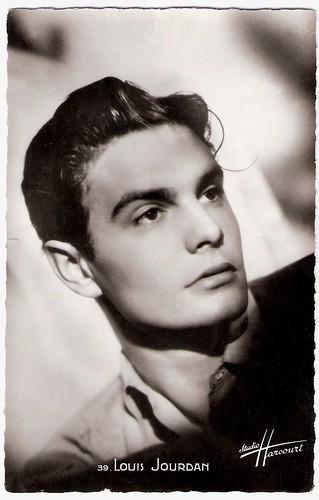
French postcard by S.E.R.P., Paris, no. 39. Photo: Studio Harcourt.
French postcard by Edition P.I., Paris, no. 43. Photo: Star.
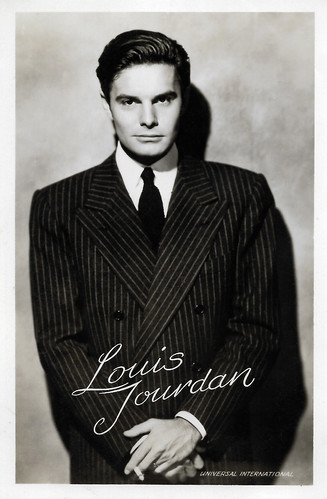
Dutch postcard by Foto-archief Film en Toneel, no. 3212. Photo: Universal International.

French postcard by S.E.R.P., Paris, no. 46. Photo: Studio Harcourt.

French postcard by Editions du Globe, Paris, no. 76. Photo: Studio Harcourt.

West German postcard by Rüdel Verlag, Hamburg-Bergedorf, no. 232. Photo: 20th Century Fox. Louis Jourdan in Bird of Paradise (Delmer Daves, 1951).
Collector card.
The most handsome French actor of his era
Louis Jourdan was born Louis Robert Gendre in Marseille, France, in 1921 (some sources say 1919 or 1920). His parents, Yvonne Jourdan and Henry Gendre managed several hotels in Cannes, Nice, and Marseille. One of his two brothers was actor-director Pierre Jourdan. Louis was educated in France, Britain, and Turkey, and in 1938 he received his dramatic training with René Simon at the Écôle Dramatique in Paris.
The following year, a talent scout discovered him and debuted on-screen in Le Corsaire (Marc Allégret, 1939) with Charles Boyer. He went on to play dashing young leads in French romantic comedies and dramas, such as La comédie du bonheur/The Comedy of Happiness (Marcel L’Herbier, 1940) with Michel Simon and Hollywood legend Ramon Novarro, and Premier rendez-vous/Her First Affair (Henri Decoin, 1941) starring Danielle Darrieux.
Following the German occupation of France during World War II, Jourdan continued to make films, including L’Arlésienne (Marc Allégret, 1942) with Raimu and Gaby Morlay, and Les petites du quai aux fleurs/The Girls of the Quai aux Fleurs (Marc Allégret, 1944) with Micheline Presle, with whom he was briefly married.
After refusing to participate in Nazi propaganda films, his budding film career was cut short. When his hotelier father was arrested by the Gestapo, Jourdan and his brothers joined the French résistance, and helped publish and distribute a newspaper for the underground. After the 1944 liberation of France by the Allies, Jourdan married for a second time. This time with his childhood sweetheart Berthe Frederique, with whom he later would have a son.
Shortly after the liberation, he was seen in leading roles in Félicie Nanteuil (Marc Allégret, 1945) with Micheline Presle and Claude Dauphin, and La Vie de Bohème/La Bohème/The Bohemian Life (Marcel L’Herbier, 1945), with María Denis. These were actually films which were already shot during the war. Jourdan was the stand-out, and he became known as the most handsome French actor of his era.
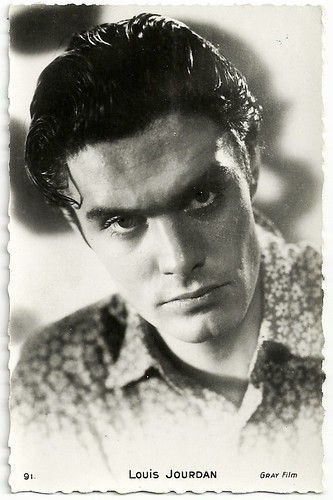
French postcard by Ed. Chantal, Rueil, no. 91. Photo: Gray Film. Publicity still for L'Arlésienne (Marc Allégret, 1942).

French postcard by Editions Continental, no. 118 A. Photo: Continental Film.

Italian postcard. María Denis and Louis Jourdan in La Vie de bohème/La Bohème/Bohème (Marcel L'Herbier, 1942-1945). The film was produced by the Italian companies Scalera and Invicta Film (Scalera was also the distributor) but was shot at the Victorine Studios in Nice in the Winter of 1942. The film was only released after the war, in October 1945. Set photos were by Aldo Graziati, who worked under the pseudonym of G.R. Aldo.
French postcard by Edition P.I., Paris, no. 141. Photo: Star.

French postcard by Editions O.P., Paris, no. 135. Photo: Star.
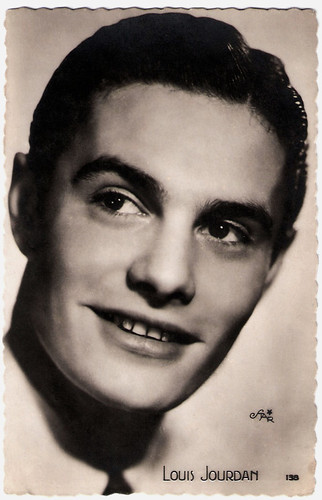
French postcard by Editions O.P., Paris, no. 138. Photo: Star.
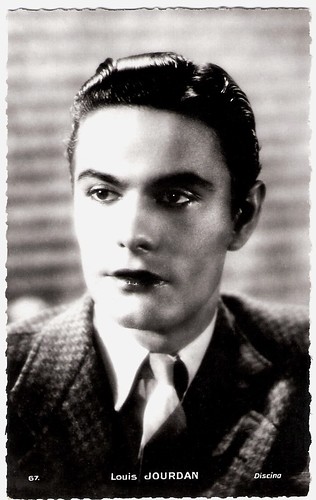
French postcard by Edition Chantal, Rueil, no. 67. Photo: Discina.
The object of secret longings
In 1946, Louis Jourdan accepted an offer from Hollywood producer David O. Selznick to appear in the crime drama The Paradine Case (Alfred Hitchcock, 1947) starring Gregory Peck and Alida Valli. He remained in the US and went on to star in several Hollywood films, including No Minor Vices (Lewis Milestone, 1948) with Dana Andrews and Lilli Palmer, Anne of the Indies (Jacques Tourneur, 1951) with Jean Peters and Debra Paget, the comedy The Happy Time (Richard Fleischer, 1952) with Charles Boyer, and Three Coins in the Fountain (Jean Negulesco, 1954) with Clifton Webb and Dorothy McGuire.
His Hollywood career was hampered by the limitations of the roles he was offered, most of which featured him as an old-fashioned European lover à la Charles Boyer. While he was memorable as the object of Joan Fontaine's secret longings in Letter from an Unknown Woman (Max Ophüls, 1948), he went on to play similar roles opposite Jennifer Jones in Madame Bovary (Vincente Minnelli, 1949) and Grace Kelly in The Swan (Charles Vidor, 1956).
In 1954 Jourdan made his Broadway debut in the lead role of Michel in 'The Immoralist'. It was a success. He returned to Broadway for a short run in 1955 and that year he was a hit on television too as Inspector Beaumont in the series Paris Precinct (1955).
He also appeared in European productions, like the Boccaccio adaptation Decameron Nights (Hugo Fregonese, 1953) with Joan Fontaine, Rue de l'Estrapade/Françoise Steps Out (Jacques Becker, 1953) with Daniel Gélin and Anne Vernon, La mariée est trop belle/The Bride is Too Beautiful (Pierre Gaspard-Huit, 1956) opposite Brigitte Bardot, and Escapade (Ralph Habib, 1957) with Dany Carrel.
However, he is best remembered for the musical Gigi (Vincente Minnelli, 1958), based on the Colette novel. He played a French playboy in his late 30s who seduced Leslie Caron the moment she came of legal age, while Maurice Chevalier sang 'Thank Heaven for Little Girls'. The film earned nine Academy Awards, including Best Picture. In 1982, he played the Chevalier role in 'Gigi' on stage, at the age of 63.
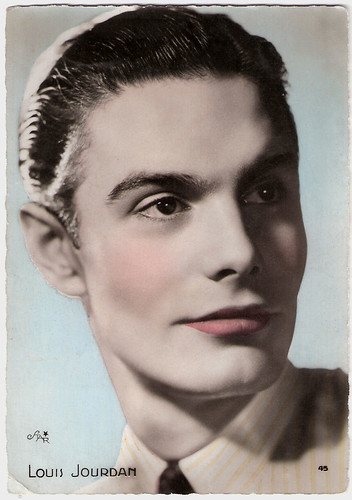
French postcard by Editions O.P., Paris, no. 45. Photo: Star.
Belgian collectors card by Fotoprim, Brussels, A 8. Photo: Universal International. Publicity photo for Letter from an Unknown Woman (Max Ophüls, 1948).

Vintage postcard, no. 552. Photo: 20th Century Fox. Publicity still for Bird of Paradise (Delmer Daves, 1951) with Debra Paget.
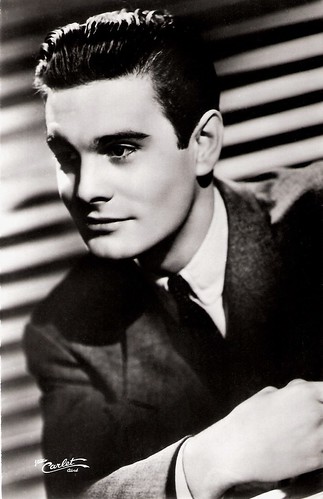
French postcard by Editions O.P., Paris, no. 60. Photo: Studio Carlet Ciné.
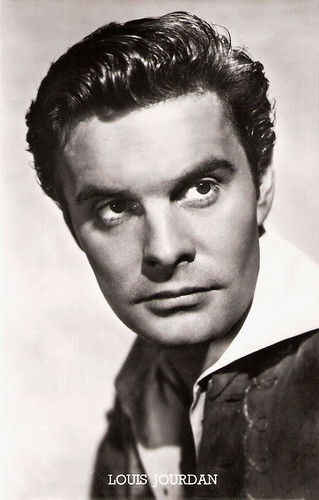
French postcard, no. 79. Photo: 20th Century Fox.

West German postcard by ISV, no. A 51. Photo: 20th Century Fox. Louis Jourdan in Three Coins in the Fountain (Jean Negulesco, 1954).

German postcard by Kolibri-Verlag G.m.b.H., Minden/Westf., no. 2887. Photo: Union-Film. Publicity still for Escapade (Ralph Habib, 1957).
Eccentric villains
During the 1960s and 1970s, Louis Jourdan kept travelling between Hollywood and Europe. He starred in films like Le Comte de Monte Cristo/The Count of Monte Cristo (Claude Autant-Lara, 1961) with Yvonne Furneaux, The V.I.P.s (Anthony Asquith, 1963) with Elizabeth Taylor, the TV film Run a Crooked Mile (Gene Levitt, 1969) with Mary Tyler Moore, a TV version of The Count of Monte-Cristo (David Greene, 1975), the BBC production Count Dracula (Mike Newell, 1977), and he was the narrator of the hit comedy Irma la Douce (Billy Wilder, 1963).
In 1981 Jourdan found his only son dead in his Beverly Hills home. Louis Henry, 29, had suffered from depression and had apparently taken an overdose of drugs. The police labelled it a suicide, even though it may have been an accidental overdose.
The next year Louis Jourdan turned to playing eccentric villains, as Dr. Anton Arcane in the campy Sci-Fi film Swamp Thing (Wes Craven, 1982) and its sequel The Return of Swamp Thing (Jim Wynorski, 1989).
He was cast as the very charming and sophisticated villain Kamal Khan in the James Bond film Octopussy (John Glen, 1983) with Roger Moore. In 1984, he played the role of Baron Pierre de Coubertin in the Emmy Award-winning TV film The First Olympics: Athens 1896 (Alvin Rakoff, 1984). After shooting Year of the Comet (Peter Yates, 1992) he retired and moved to the south of France.
Louis Jourdan lived - part-time in the greater Los Angeles area and part-time in the South of France - with his wife for more than sixty years, Berthe Frederique. In July 2010, Jourdan was made a Chevalier de la Legion d'honneur. Berthe died in 2014, and a year later, Jourdan passed away at his home in Beverly Hills at the age of 93.

Italian postcard. Photo: Metro Goldwyn Mayer. Publicity still for Made in Paris (Boris Sagal, 1966) with Ann-Margret.
Trailer for Letter From an Unknown Woman (1948). Source: Xaatt (YouTube).
Trailer for The Swan (1956). Source: Jimusnr (YouTube).
Trailer for Gigi (1958). Source: Webothlovesoup (YouTube).
Trailer for for Made in Paris (1966). Source: Movieclips (YouTube).
Trailer for Octopussy (1983). Source: Chigawa's channel (YouTube).
Sources: Ephraim Katz (The Film Encyclopedia), Ohad Rosen (IMDb), Yahoo Movies (now defunct), Filmreference.com, NNDB, Wikipedia, and IMDb.
Goodness! These postcards have certainly stolen my heart! What a tragedy he experienced losing his dear son at such a tender age... Now I recognize him from the Madame Bovary film that I know so well! I am on the hunt now for European Film Postcards to send you! I have my eyes peeled for your glorious collection!
ReplyDeleteWOW!!!! These cards are wonderful. Thanks for sharing.
ReplyDeletedebby
I just watched the Swan clip.. he is so intense and soft spoken! What a dashing man!
ReplyDeleteAn interesting life, and he must be almost unique in the film star world, in staying married to the same person all that time.
ReplyDeleteAh he was so very handsome .. recently watched GiGi ... thanks for sharing!
ReplyDeleteHello Bob
ReplyDeleteOh my what a very handsome man .
His life was certainly a difficult one .I cannot imagine the sadness
of loosing your son so young.
You always find the most unique cards and wonderful background information.
Thank you so much for sharing today.
I really enjoy my visits to your site.
Happy PFF to you .
Have a fun filled weekend.
Happy Trails
I didn't realize there was going to be a drool factor when I popped over here :)
ReplyDeleteOne of the best postcard in this week's PFF. I like black & white postcard
ReplyDeleteDear PFF Friends, Thank you all for stopping by. Have a good and sunny Pentecost. Till next Friday!
ReplyDeleteMost movie stars are handsome and beautiful! aren't they?
ReplyDeletethank you for sharing their stories and dropping by at my blog.
Wish you a great week.
I had no idea Jourdan had such a long lasting marriage. When I was growing up he was the archetype of European sophistication.
ReplyDelete